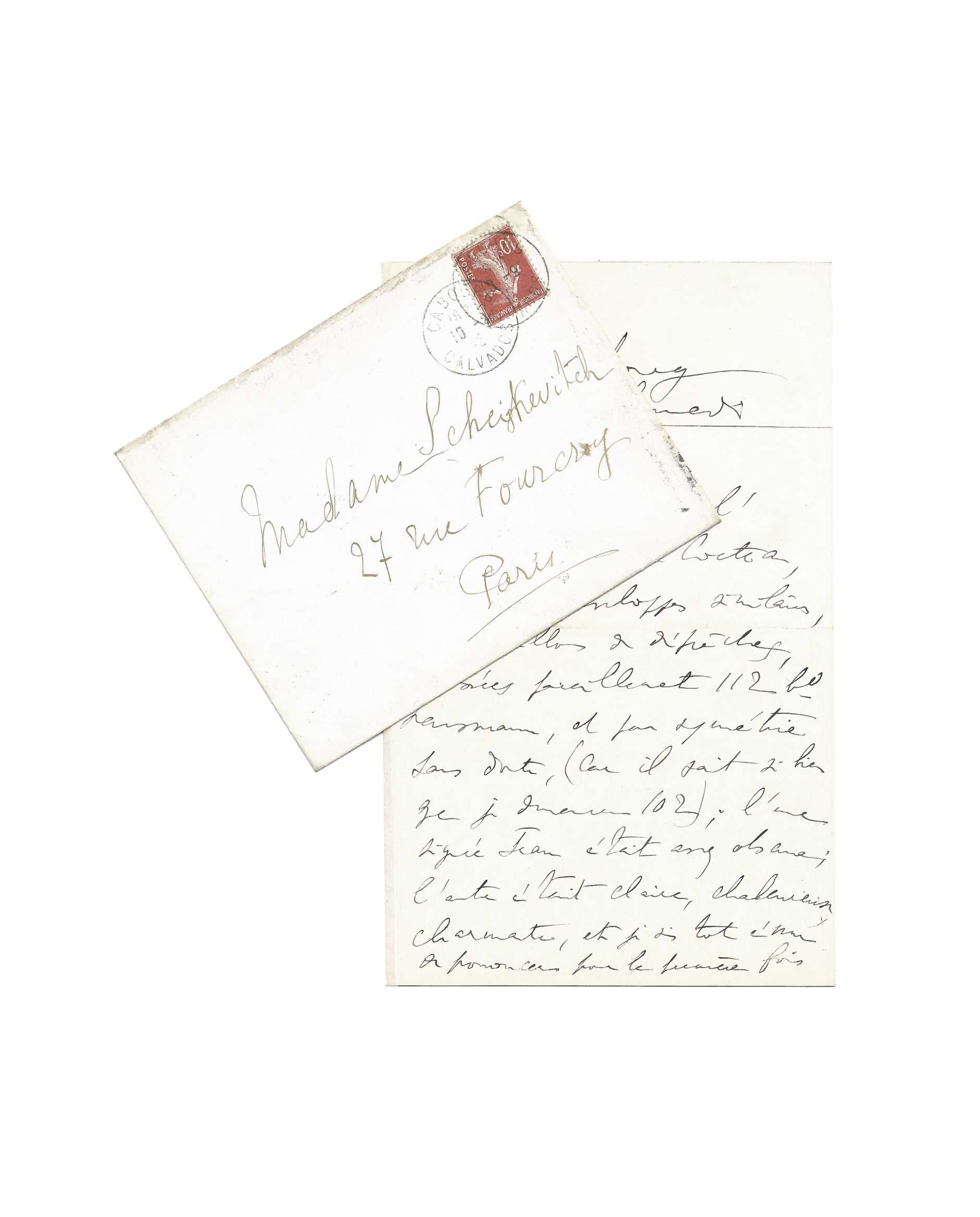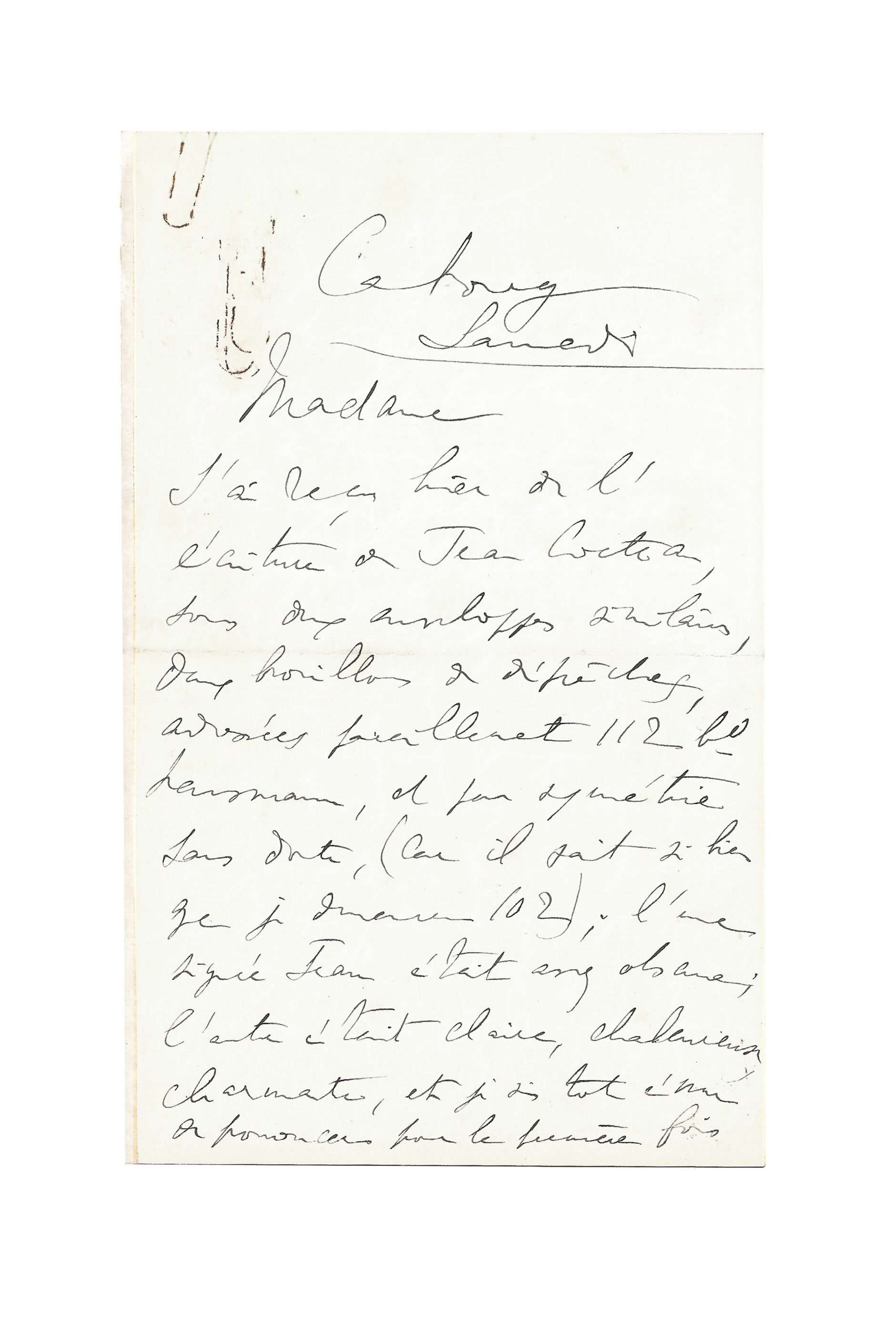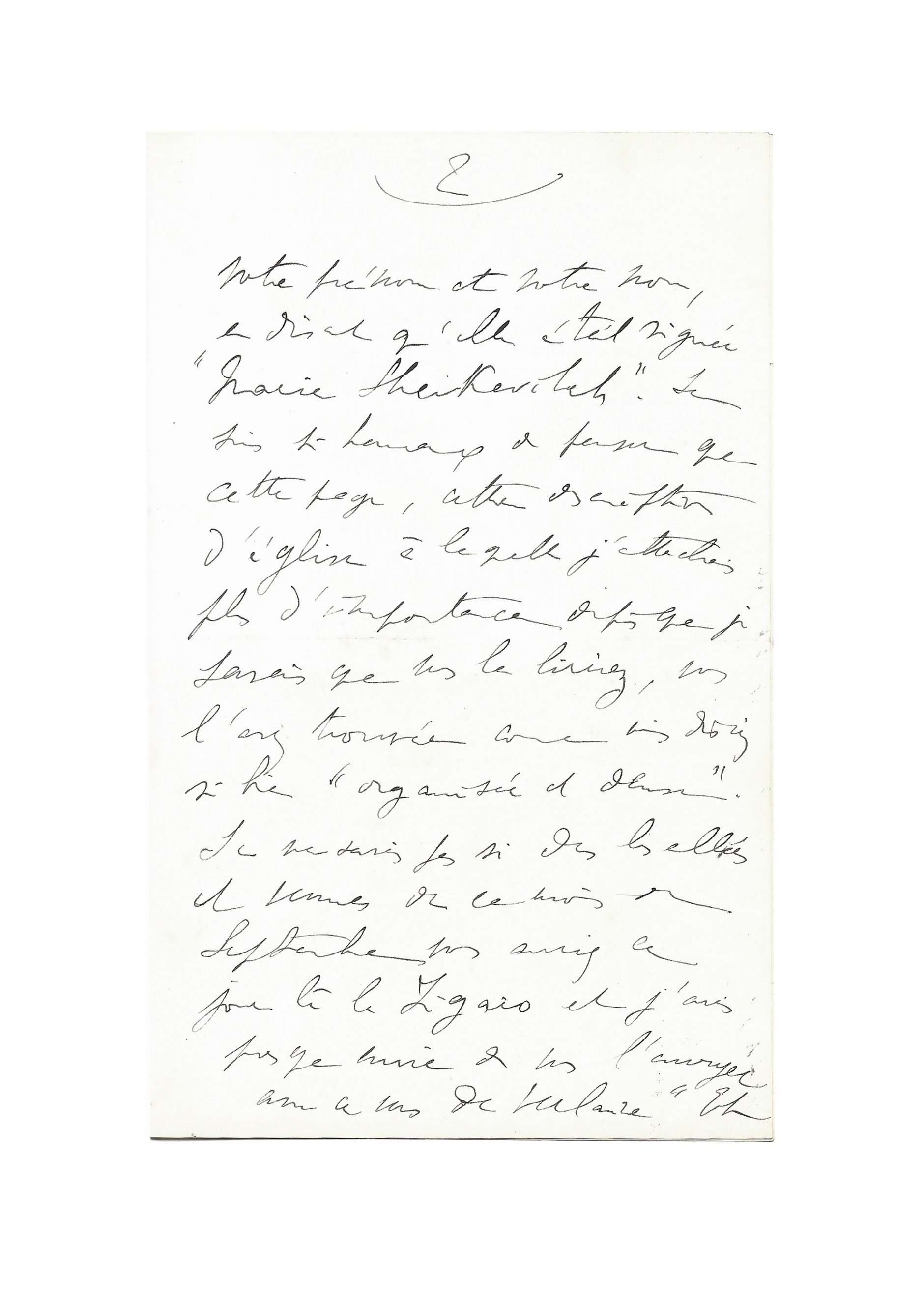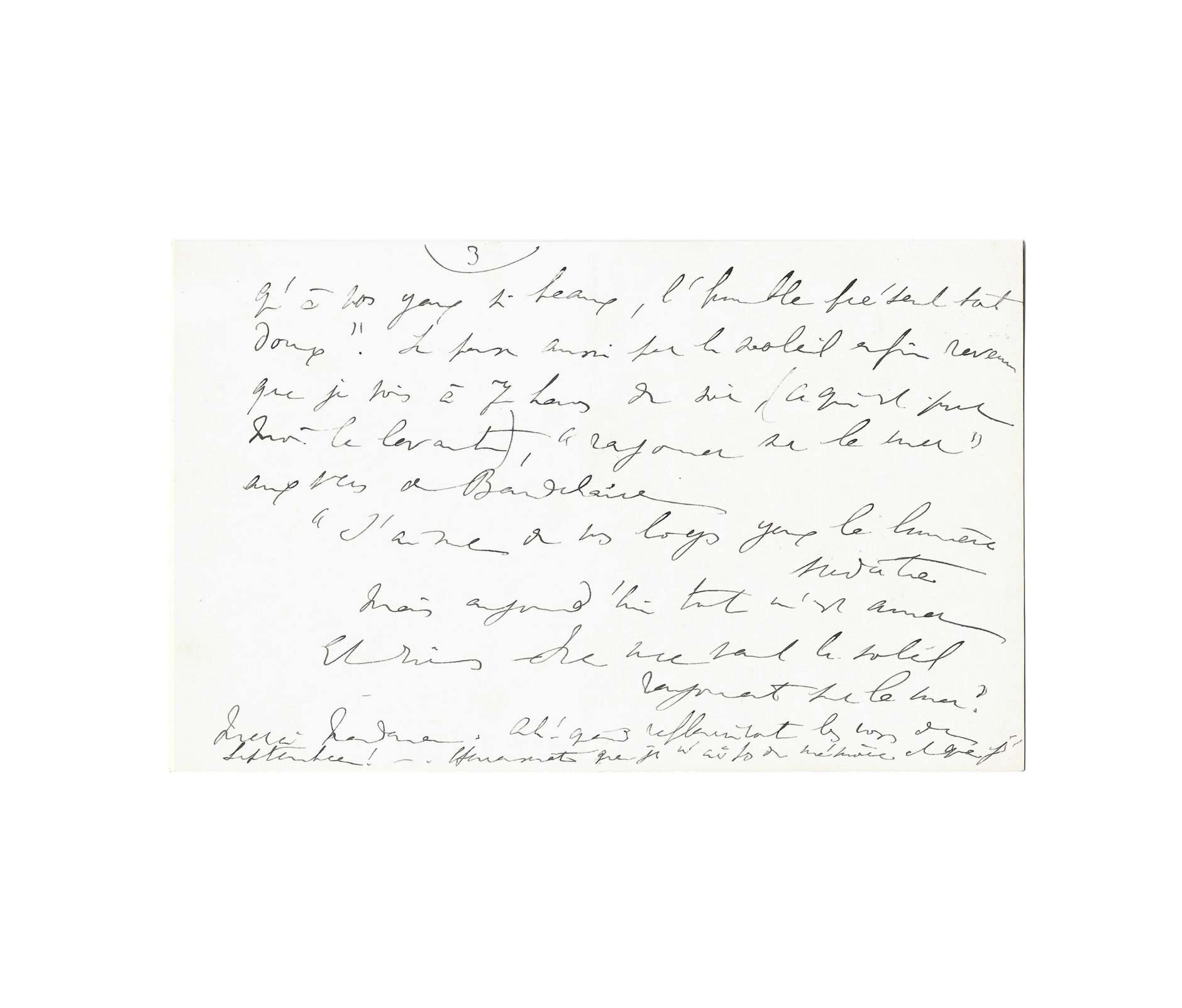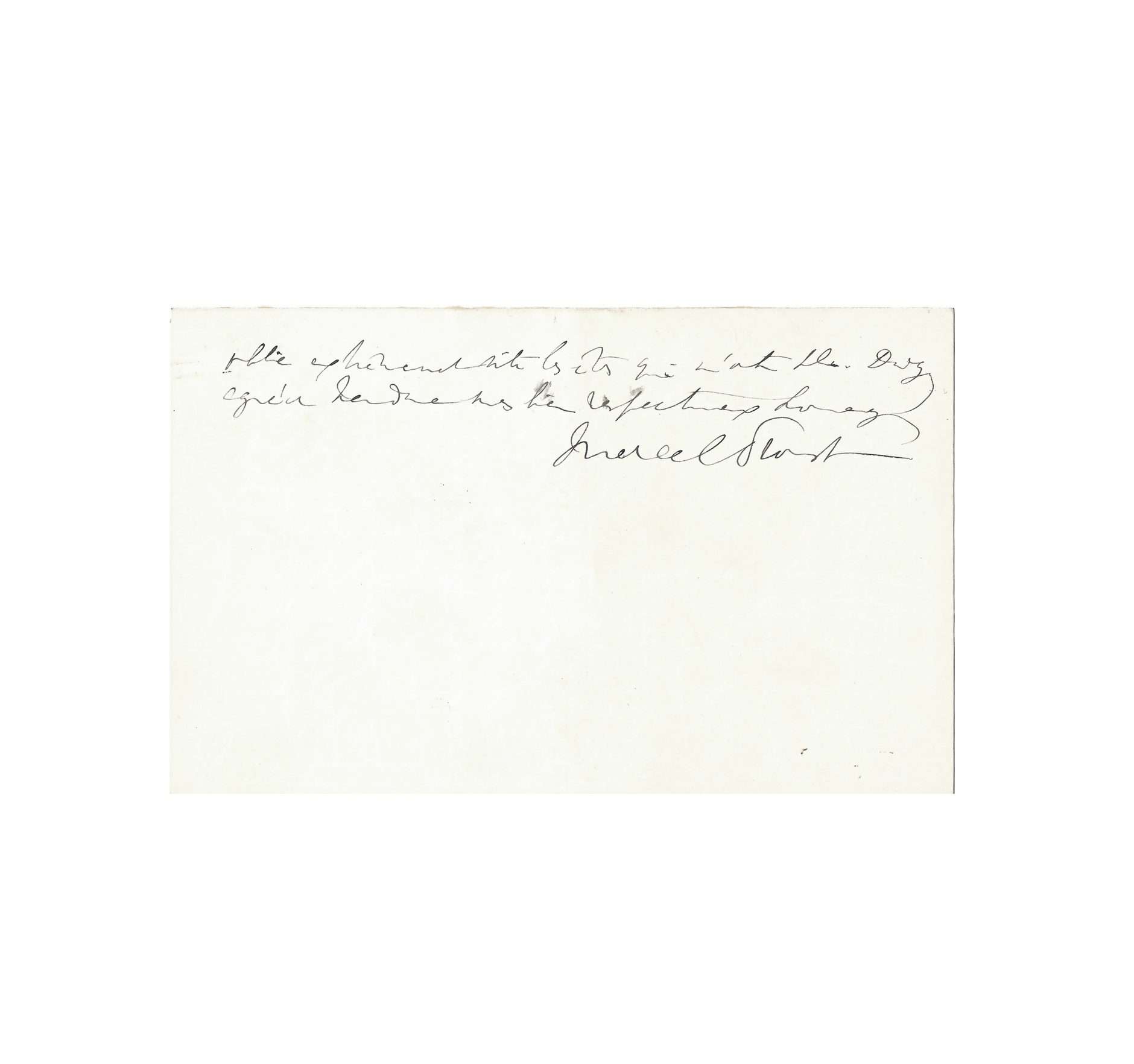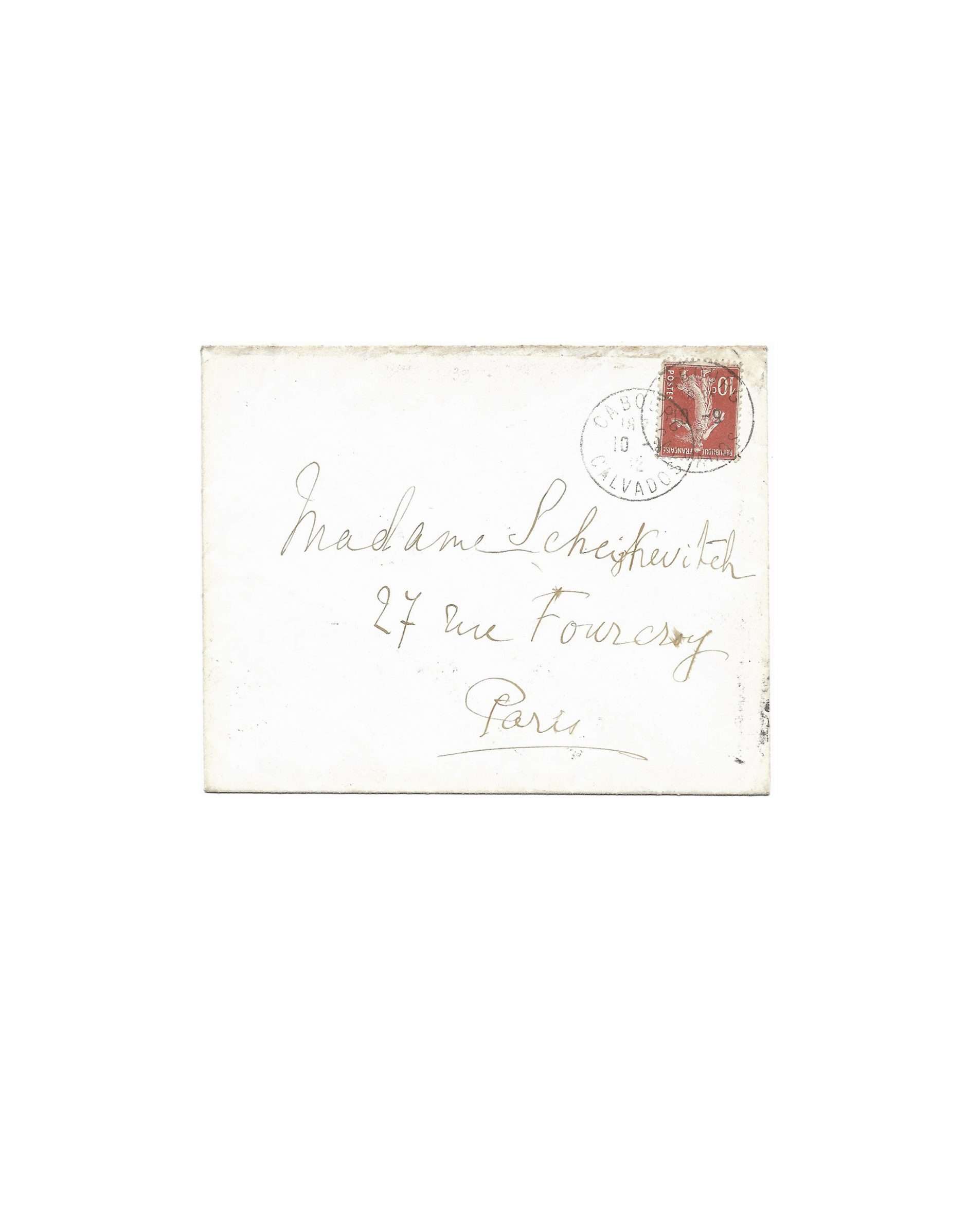PROUST, Marcel (1871-1922)
Autograph letter signed « Marcel Proust » to Marie Scheikévitch
Cabourg, [5th September 1912], 3 p. 1/2 in-8°
« Fortunately, I have no memory and I forget extremely quickly the people I liked »
Fact sheet
PROUST, Marcel (1871-1922)
Autograph letter signed « Marcel Proust » to Marie Scheikévitch
Cabourg, [5th September 1912], 3 p. 1/2 in-8°
With stamped autograph envelope
Small marks of paper clip, old trace of mounting, without affecting the text
Proust’s very first known letter to Marie Sheikevich
The writer is moved by the praise made by his correspondent on his article, recently published in Le Figaro: « L’Église de village », and some fragments of which will be taken up in Combray, the following year, at the publication of the first volume of The Search
Clearly troubled, he ends his missive by quoting Verlaine and Baudelair
« Madame,
J’ai reçu hier de l’écriture de Jean Cocteau, sous deux enveloppes similaires, deux brouillons de dépêches, adressées pareillement 112, boulevard Haussmann, et par symétrie sans doute (car il sait si bien que je demeure 102) ; l’une signée Jean était assez obscure ; l’autre était claire, chaleureuse, charmante, et je suis tout ému de prononcer pour la première fois votre prénom et votre nom, en disant qu’elle était signée « Marie Scheikévitch »(1).
Je suis si heureux de penser que cette page, cette description d’église à laquelle j’attachais plus d’importance depuis que je savais que vous la liriez(2), vous l’avez trouvée, comme vous disiez si bien, « organisée et dense ». Je ne savais pas si, dans les allées et venues de ce mois de septembre, vous auriez ce jour-là le Figaro et j’avais presque envie de vous l’envoyer avec ce vers de Verlaine :
Et qu’à vos yeux si beaux, l’humble présent soit doux(3).
Je pense aussi, par le soleil enfin revenu que je vois à sept heures du soir (ce qui est pour moi le levant) « rayonner sur la mer », aux vers de Baudelaire :
J’aime de vos longs yeux la lumière verdâtre…
… mais aujourd’hui tout m’est amer(4),
Et rien,
Ne me vaut le soleil rayonnant sur la mer.
Merci, Madame.
Ah ! quand refleuriront les roses de septembre ?…(5)
Heureusement que je n’ai pas de mémoire et que j’oublie extrêmement vite les êtres qui m’ont plu(6). Daignez agréer, Madame, mes bien respectueux hommages.
Marcel Proust »
1 – “One day when Mr. Jean Cocteau was having lunch at Mrs. Scheikévitch’s, he had read together, in the Figaro of September 3, 1912, a charming and brilliant article by Marcel Proust, written about La Grande Pitié des Églises de France, which had just been published, and entitled L’Église de mon village [L’Église de village]. They had decided to compliment the author, and they had written two dispatches which M. Jean Cocteau had undertaken to post to the post, and which, remembering that Proust was absent from Paris, he had preferred to send him in an envelope . . . Lettres, p. 127, note 1.
2 – Proust is referring, it seems, to the two interviews he had with Marie Scheikévitch at Cabourg, during which he had to announce to her the forthcoming appearance of his article in Le Figaro.
3 – Verlaine, Green (Romances sans paroles, Aquarelles), fourth verse of the first stanza
4 – Baudelaire, Chant d’automne, fifth stanza. Proust does not dare to put, after the first verse of the stanza, the following words: Douce beauté. He omits part of the following verse
5 – Verlaine, L’espoir luit comme un brin de paille (Sagesse, third part), last verses
6 – Proust takes precautions. In a letter to Reynaldo Hahn a fortnight earlier, he wrote: “I had a second interview with Mrs. Scheikevich. And as here [Cabourg] I am very destitute, the slightest pleasant woman troubles me a little and I show her in spite of myself a kind of sympathy that I do not support afterwards. ”
An intimate of Proust who did much effort in using her network for the publication of the first volume of The Search :
Marie Scheikevitch (1882-1964) was the daughter of a wealthy Russian magistrate and art collector who settled in France in 1896. George D. Painter described her as “one of the smartest and most prominent ladies of the new generation.” Patron of artists and writers, she frequented salons and then founded her own. She was friends with Jean Cocteau, Anna de Noailles, Reynaldo Hahn, the Arman de Caillavet family, among others.
A feeling of singular quality united Marcel Proust to Marie Scheikévitch. Although they met briefly in 1905 in Mme Lemaire’s salon, it was in 1912 that they really get to know eachother. There followed a correspondence that lasted until 1922, the year of the writer’s death. Seeing each other “almost every day” as she would later say (friends writing all the less as they see each other more), we know only 28 letters from Proust addressed to her.
She opened to him the doors of her salon, frequented by all that Paris had of illustrious personalities in literature and arts, so that he paid tribute to her in Sodome et Gomorrhe under the veil of Madame Timoléon d’Amoncourt, “a charming little woman, of a spirit, like her beauty, so ravishing, that only one of the two would have succeeded in pleasing “.
A fervent admirer of the writer, she spent a great deal at the time of the publication of the first volume of The Search, trying everything to put Proust in touch with the Parisian personalities she considered most capable of helping him. It was she who recommended him to her lover Adrien Hébrard, the influential director of the newspaper Le Temps, to obtain the famous interview of November 12, 1913 by Élie-Joseph Bois, on the eve of Swann‘s publication: This was the first significant article published in the major press and devoted to The Search. To thank her, Proust sent her a major inscription (recently acquired by the BnF) when Swann was published.
References :
La Revue de Paris, 34 (15 December 1927)
Lettres à Madame Scheikévitch (1928), pp. 39-40
Correspondance, Kolb, t. XI, n°113
Marcel Proust II – Biographie, Jean-Yves Tadié, Folio, pp. 391-392
